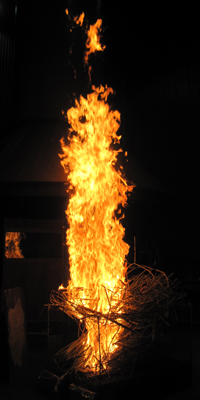Press Release: Carnegie Mellon Sheds Light on "Brown" Carbon's Role in Warming the Planet
Contact: Daniel Tkacik / 412-268-1187 / dtkacik@andrew.cmu.edu
 PITTSBURGH—A team of researchers has uncovered key attributes of so-called "brown carbon," atmospheric particles that play an important role in warming the atmosphere but are poorly understood. The team, led by Carnegie Mellon University with scientists from the Los Alamos National Laboratory and the University of Montana, said these findings, published this week in the journal Nature Geoscience, could help improve global climate predictions.
PITTSBURGH—A team of researchers has uncovered key attributes of so-called "brown carbon," atmospheric particles that play an important role in warming the atmosphere but are poorly understood. The team, led by Carnegie Mellon University with scientists from the Los Alamos National Laboratory and the University of Montana, said these findings, published this week in the journal Nature Geoscience, could help improve global climate predictions.
"We found order in the chaos," said Rawad Saleh, a postdoctoral researcher at Carnegie Mellon and lead author of the study. "Now we have this framework that unifies the seemingly discordant results reported by various research groups: the warming effect of brown carbon depends on the conditions under which it is produced."
The team focused on the major sources of brown carbon: wildfires. Smoke from wildfires accounts for one-third of the Earth's "black" carbon — the familiar black soot that is second only to carbon dioxide in warming the planet. While black carbon is relatively simple — consisting solely of carbon — brown carbon contains a complex soup of organic material, making it difficult to identify, characterize and model.
"You might call brown carbon frustrated black carbon," said Neil Donahue, a professor of chemical engineering at Carnegie Mellon and a principal investigator of the study. "You get brown carbon when the wood isn't fully cooked all the way."
Brown carbon warms the atmosphere similarly to black carbon, but the prevalence and warming efficiency of brown carbon in wildfire smoke has been a large question mark.
To study brown carbon from wildfires, the researchers simulated a series of wood burning events, setting fire to a range of tree, grass, and brush types representative of vegetation in areas known for wildfires. The team then measured the smoke's ability to absorb light — and thus to induce warming — with a collection of state-of-the-art air monitoring equipment.
The study found that the amount of brown carbon produced in a fire had little dependence on what was being burned. Instead, brown carbon emissions correlated with the amount of black carbon in the smoke, which is dictated by the burning conditions, such as flaming and smoldering phases, and is relatively easy to measure.
"That's a huge simplification in terms of estimating the emissions of brown carbon and predicting the effects on climate," said Allen Robinson, head of Carnegie Mellon's Department of Mechanical Engineering and a principal investigator of the study. "If every different tree produced different amounts of brown carbon, that just makes it really, really complicated."
Saleh said the study design was helped by insight gained in the collaborative atmosphere in the Center for Atmospheric Particle Studies, an air quality research group spanning five departments at Carnegie Mellon, where experimentalists and modelers work side-by-side.
"We are one of the very few groups who have both experimentalists and modelers," Saleh said. "We sort of understand each other's languages and we, as experimentalists, know what the modelers need, and we have this in mind when we design and analyze the experiments."
The collaborative research was supported by the Department of Energy Atmospheric Science Research Program and The National Science Foundation Atmospheric Chemistry Program.
###
To study brown carbon from wildfires, the researchers simulated a series of wood burning events (pictured above), setting fire to a range of tree, grass, and brush types representative of vegetation in areas known for wildfires.